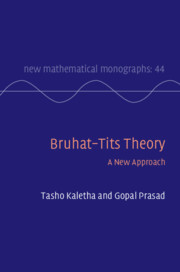Book contents
- Frontmatter
- Dedication
- Contents
- Illustrations
- Tables
- Introduction
- Part One Background and Review
- Part Two Bruhat–Tits Theory
- 3 Examples: Quasi-split Simple Groups of Rank 1
- 4 Overview and Summary of Bruhat–Tits Theory
- 5 Bruhat, Cartan, and Iwasawa Decompositions
- 6 The Apartment
- 7 The Bruhat–Tits Building for a Valuation of the Root Datum
- 8 Integral Models
- 9 Unramified Descent
- Part Three Additional Developments
- Part Four Applications
- Part Five Appendices
- References
- Index of Symbols
- General Index
5 - Bruhat, Cartan, and Iwasawa Decompositions
from Part Two - Bruhat–Tits Theory
Published online by Cambridge University Press: 16 May 2023
- Frontmatter
- Dedication
- Contents
- Illustrations
- Tables
- Introduction
- Part One Background and Review
- Part Two Bruhat–Tits Theory
- 3 Examples: Quasi-split Simple Groups of Rank 1
- 4 Overview and Summary of Bruhat–Tits Theory
- 5 Bruhat, Cartan, and Iwasawa Decompositions
- 6 The Apartment
- 7 The Bruhat–Tits Building for a Valuation of the Root Datum
- 8 Integral Models
- 9 Unramified Descent
- Part Three Additional Developments
- Part Four Applications
- Part Five Appendices
- References
- Index of Symbols
- General Index
Summary
Provides the first major application of Bruhat--Tits theory, namely the various decompositions of the topological group $G(k)$ known under the names of Bruhat, Cartan, and Iwasawa. These decompositions are an essential tool in the study of representation theory and harmonic analysis on $G(k)$.
- Type
- Chapter
- Information
- Bruhat–Tits TheoryA New Approach, pp. 186 - 194Publisher: Cambridge University PressPrint publication year: 2023

